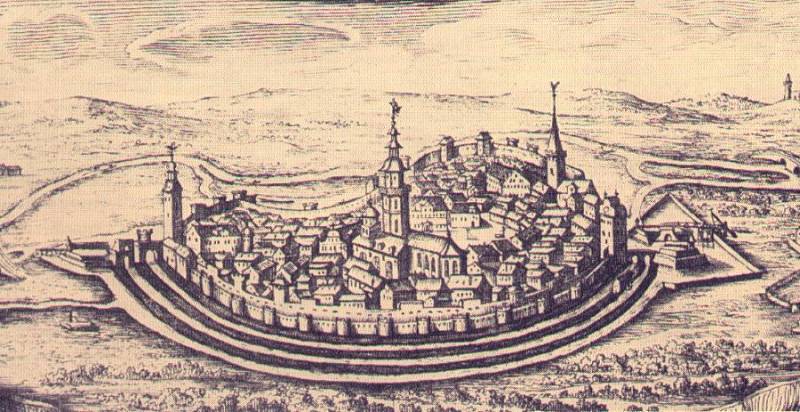|
Altenstein Palace
Schloss Altenstein is a '' schloss'', or palace, upon a rocky hill on the south-western slope of the Thuringian Forest, not far from Eisenach, Thuringia, Germany. It was the summer residence of the Dukes of Saxe-Meiningen, and is surrounded by 160 hectares (1.6 square kilometres) of English landscape garden, which contain, among other objects of interest, a cavern 300 metres long, through which flows a large and rapid stream. Geography Altenstein is a part of the municipality of Bad Liebenstein in the Wartburgkreis near Eisenach, Thuringia, Germany. It sits on a platform with a height of around 460 metres above sea level, part of the dolomite hills at the western edge of the Thuringian Forest. It is surrounded by 160 hectares of park, which includes several pinnacles of Zechstein rock. History Previous structures A fortified structure, possibly initially a pre-Christian holy site, may have been roughly in the same location as the current house by the 6th century. The ... [...More Info...] [...Related Items...] OR: [Wikipedia] [Google] [Baidu] |
Renaissance Revival Architecture
Renaissance Revival architecture (sometimes referred to as "Neo-Renaissance") is a group of 19th century architectural revival styles which were neither Greek Revival nor Gothic Revival but which instead drew inspiration from a wide range of classicizing Italian modes. Under the broad designation Renaissance architecture nineteenth-century architects and critics went beyond the architectural style which began in Florence and Central Italy in the early 15th century as an expression of Renaissance humanism; they also included styles that can be identified as Mannerist or Baroque. Self-applied style designations were rife in the mid- and later nineteenth century: "Neo-Renaissance" might be applied by contemporaries to structures that others called "Italianate", or when many French Baroque features are present (Second Empire). The divergent forms of Renaissance architecture in different parts of Europe, particularly in France and Italy, has added to the difficulty of defining an ... [...More Info...] [...Related Items...] OR: [Wikipedia] [Google] [Baidu] |
Zechstein
The Zechstein (German either from ''mine stone'' or ''tough stone'') is a unit of sedimentary rock layers of Middle to Late Permian (Guadalupian to Lopingian) age located in the European Permian Basin which stretches from the east coast of England to northern Poland. The name Zechstein was formerly also used as a unit of time in the geologic timescale, but nowadays it is only used for the corresponding sedimentary deposits in Europe. The Zechstein lies on top of the Rotliegend; on top of the Zechstein is the Buntsandstein or Bunter. Formation The evaporite rocks of the Zechstein formation were laid down by the Zechstein Sea, an epicontinental or epeiric sea that existed in the Guadalupian and Lopingian epochs of the Permian period. The Zechstein Sea occupied the region of what is now the North Sea, plus lowland areas of Britain and the north European plain through Germany and Poland. The Zechstein sea lay in the rain shadow of the Central Pangean Mountains to the south. At times ... [...More Info...] [...Related Items...] OR: [Wikipedia] [Google] [Baidu] |
Robber Baron (feudalism)
A robber baron or robber knight (german: Raubritter) was an unscrupulous feudal landowner who, protected by his fief's legal status, imposed high taxes and tolls out of keeping with the norm without authorization by some higher authority. Some resorted to actual banditry. The German term for robber barons, ''Raubritter'' (robber knights), was coined by Friedrich Bottschalk in 1810.Klaus Graf, "Feindbild und Vorbild: Bemerkungen zur stadtischen Wahrnehmung des Adels", ''ZGO'' 141 (1993), pp. 121–154, at 138 Some robber barons violated the custom under which tolls were collected on the Rhine either by charging higher tolls than the standard or by operating without authority from the Holy Roman Emperor altogether. During the period in the history of the Holy Roman Empire known as the Great Interregnum (1250–1273), the number of such tolling stations exploded in the absence of Imperial authority. Medieval robber barons most often imposed high or unauthorized tolls on rivers or ro ... [...More Info...] [...Related Items...] OR: [Wikipedia] [Google] [Baidu] |
Gumpelstadt
Gumpelstadt is a village of the Moorgrund municipality in the Wartburgkreis district in Thuringia, Germany (since 1994). Geography Gumpelstadt is located at an altitude of about 280 meters on the southwest edge of the Thuringian Forest and about five kilometers northeast of Bad Salzungen. History Gumpelstadt was first mentioned in 1155. It was first a territory of the Fulda monastery. In 1346 it was take over by the House of Wettin. Between 1629 and 1664 there were witch trials held in Gumpelstadt in which a woman and a man were burned to death and a woman died under torture. In 1680, with the fracturing of the Ernestine duchies, Gumpelstadt became part of the Principality of Saxe-Meiningen Saxe-Meiningen (; german: Sachsen-Meiningen ) was one of the Saxon duchies held by the Ernestine line of the Wettin dynasty, located in the southwest of the present-day German state of Thuringia. Established in 1681, by partition of the Ernestin .... It was first part of Amt Alten ... [...More Info...] [...Related Items...] OR: [Wikipedia] [Google] [Baidu] |
Schweina
Schweina is a village and a former municipality in the Wartburgkreis district of Thuringia, Germany. Since 31 December 2012, it is part of the town Bad Liebenstein Bad Liebenstein is a municipality and spa town in Wartburgkreis district of Thuringia, Germany. Geography Location Bad Liebenstein is situated 25 km north of Meiningen, and 18 km south of Eisenach. It is located in the ''Mittelgebirge' .... Former municipalities in Thuringia Duchy of Saxe-Meiningen {{Wartburgkreis-geo-stub ... [...More Info...] [...Related Items...] OR: [Wikipedia] [Google] [Baidu] |
Steinbach, Wartburgkreis
Steinbach is a village and former municipality in the Wartburgkreis district of Thuringia, Germany Germany,, officially the Federal Republic of Germany, is a country in Central Europe. It is the second most populous country in Europe after Russia, and the most populous member state of the European Union. Germany is situated betwe .... Since 31 December 2012, it is part of Bad Liebenstein. References Former municipalities in Thuringia {{Wartburgkreis-geo-stub ... [...More Info...] [...Related Items...] OR: [Wikipedia] [Google] [Baidu] |
Frederick III, Landgrave Of Thuringia
Frederick III, the Strict (''Friedrich III. der Strenge''; 14 December 1332, Dresden – 21 May 1381, Altenburg), Landgrave of Thuringia and Margrave of Meissen, was the son of Frederick II, Margrave of Meissen and Mathilde of Bavaria.Harald Schieckel: Friedrich III. der Strenge. In: Neue Deutsche Biographie (NDB). Band 5, Duncker & Humblot, Berlin 1961, ISBN 3-428-00186-9 He took over the government for his brothers William, Balthasar and Ludwig (Bishop of Bamberg) after the death of their father in 1349. One year later the Emperor gave the Margraviate of Meissen to the four brothers jointly. In 1368 common government began, afterwards the brothers changed rulership every two years. In 1379 they divided their possessions. After Frederick III's death, Meissen was divided between his three sons and Thuringia was inherited by his brothers; it later passed to his nephew Frederick IV, Landgrave of Thuringia, son of his brother Balthasar, and was ultimately inherited by Frede ... [...More Info...] [...Related Items...] OR: [Wikipedia] [Google] [Baidu] |
Meiningen
Meiningen () is a town in the southern part of the state of Thuringia, Germany. It is located in the region of Franconia and has a population of around 25,000 (2021)." target="_blank" class="mw-redirect" title="City of Meiningen, citizen service">City of Meiningen, citizen service Jahresrückblick 2021 (year review), PDF (4,4 MB). Meiningen is the capital and the largest town of the Schmalkalden-Meiningen district. From 1680 to 1920, Meiningen was the capital of the Duchy (and briefly of the Free State) of Saxe-Meiningen. Meiningen is considered the cultural, judicial and financial centre of southern Thuringia and thus hosts the state theatre, justice center, state archives, bank buildings and many museums. It is economically reliant on mechanical engineering, high-tech industry and tourism. The dialect ... [...More Info...] [...Related Items...] OR: [Wikipedia] [Google] [Baidu] |
Frederick II, Margrave Of Meissen
Frederick II (; 30 November 1310 – 18 November 1349) was the margrave of Meissen from 1323 until his death. Early life Frederick was born on 30 November 1310 in Gotha. His parents were Margrave Frederick I of Meissen and Elisabeth von Lobdeburg-Arnshaugk. In 1323, under the guardianship of his mother, he succeeded his father in the Margraviate of Meissen and Thuringia. Personal rule After reaching the age of majority in 1329, he had to pass long-term fights with the vassals and neighbours. These conflicts mainly rose due to Frederick's declaration of peace in 1338, which drastically diminished the rights and influence of the small landlords and the local rulers, and which goal was the subjugation of the latter two groups. In 1342, dissatisfied nobles, whose concerns were their rights and independence, banded together in Arnstadt (southwest of Erfurt) against Frederick II, in what would be known as the Thuringian Count's War. The conflict would last up to 1346. After the de ... [...More Info...] [...Related Items...] OR: [Wikipedia] [Google] [Baidu] |
House Of Henneberg
The House of Henneberg was a medieval German comital family (''Grafen'') which from the 11th century onwards held large territories in the Duchy of Franconia. Their county was raised to a princely county (''Gefürstete Grafschaft'') in 1310. Upon the extinction of the line in the late 16th century, most of the territory was inherited by the Saxon House of Wettin and subsequently incorporated into the Thuringian estates of its Ernestine branch. Origins The distant origins of this family are speculative yet seem to originate in the Middle Rhine Valley, east of modern-day France. Charibert, a nobleman in Neustria is the earliest recorded ancestor of the family, dating before 636. Five generations pass between Charibert and the next descendant of note, Robert III of Worms. Both the Capetian dynasty and the Elder House of Babenberg (Popponids) are direct male lineal descendants of Count Robert I and therefore referred to as Robertians. The designation ''Babenberger'', from the castl ... [...More Info...] [...Related Items...] OR: [Wikipedia] [Google] [Baidu] |
Duchy Of Thuringia
The Duchy of Thuringia was an eastern frontier march of the Merovingian dynasty, Merovingian kingdom of Austrasia, established about 631 by King Dagobert I after his troops had been defeated by the forces of the Samo, Slavic confederation of Samo at the Battle of Wogastisburg. It was recreated in the Carolingian Empire and its dukes were appointed by the King of Germany, king until it was absorbed by the Duchy of Saxony, Saxon dukes in 908. From about 1111/12 the territory was ruled by the Landgraves of Thuringia as Princes of the Holy Roman Empire. History The former kingdom of the Thuringii arose during the Migration Period after the decline of the Huns, Hunnic Empire in Central Europe in the mid 5th century, culminating in their defeat in the 454 Battle of Nedao. With Bisinus a first List of rulers of Thuringia, Thuringian king is documented about 500, who ruled overextended estates that stretched beyond the Main (river), Main River in the south. His son and successor Hermanaf ... [...More Info...] [...Related Items...] OR: [Wikipedia] [Google] [Baidu] |



